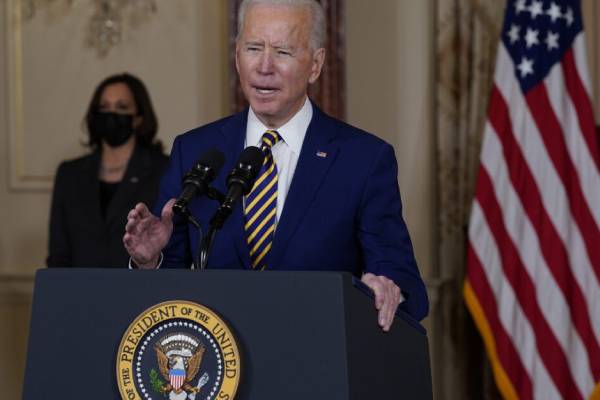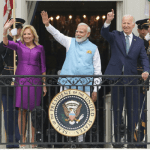President Joe Biden has announced new steps to address student loan debt, which includes forgiving up to $20,000 for some borrowers and extending the payment freeze one final time until the end of the year.
The President’s sweeping plan on student loans follows extended, down-to-the-wire negotiations at the White House among stakeholders and lawmakers ahead of when payments were set to resume at the end of this month.
The decision is already disappointing many, with those on the left arguing that the President should have provided even more loan forgiveness and those on the right asserting that Biden is punishing Americans who avoided going into debt.
But it fulfills one of Biden’s campaign promises, issuing major reforms to America’s student loan system and providing relief to millions of current and future borrowers.
The President will speak at 2:15 p.m. ET to formally announce the plan.
“In keeping with my campaign promise, my Administration is announcing a plan to give working and middle class families breathing room as they prepare to resume federal student loan payments in January 2023,” Biden said on Twitter announcing the plan.
Borrowers who hold loans with the Department of Education and make less than $125,000 a year are eligible for up to $20,000 in student loan forgiveness if they obtained Pell Grants. Individuals who make less than $125,000 a year but did not receive Pell Grants are eligible for $10,000 in loan forgiveness.
The Department of Education will announce details on how borrowers can claim this relief in the coming weeks, with the application expected to be available no later than when the pause on repayments terminates at the end of December. Millions of borrowers will be able to receive relief automatically based on existing income data.
Additionally, the department is proposing a federal rule aimed at making the student loan system more manageable for current and future borrowers.
The proposed rule would change income-based repayment for student loans, cutting in half the amount borrowers would have to pay each month on their undergraduate loans, “while borrowers with both undergraduate and graduate loans will pay a weighted average rate.”
The proposal would also “raise the amount of income that is considered non-discretionary income and therefore protected from repayment.” And it would forgive loan balances after 10 years of payments rather than 20 years under many income-driven repayment plans for borrowers with original loan balances of $12,000 or less, the department said.
The proposed rule includes other changes, like simplifying borrowers’ choices among loan repayment plans.
President Joe Biden has announced new steps to address student loan debt, which includes forgiving up to $20,000 for some borrowers and extending the payment freeze one final time until the end of the year.
The President’s sweeping plan on student loans follows extended, down-to-the-wire negotiations at the White House among stakeholders and lawmakers ahead of when payments were set to resume at the end of this month.
The decision is already disappointing many, with those on the left arguing that the President should have provided even more loan forgiveness and those on the right asserting that Biden is punishing Americans who avoided going into debt.
But it fulfills one of Biden’s campaign promises, issuing major reforms to America’s student loan system and providing relief to millions of current and future borrowers.
The President will speak at 2:15 p.m. ET to formally announce the plan.
“In keeping with my campaign promise, my Administration is announcing a plan to give working and middle class families breathing room as they prepare to resume federal student loan payments in January 2023,” Biden said on Twitter announcing the plan.
Borrowers who hold loans with the Department of Education and make less than $125,000 a year are eligible for up to $20,000 in student loan forgiveness if they obtained Pell Grants. Individuals who make less than $125,000 a year but did not receive Pell Grants are eligible for $10,000 in loan forgiveness.
The Department of Education will announce details on how borrowers can claim this relief in the coming weeks, with the application expected to be available no later than when the pause on repayments terminates at the end of December. Millions of borrowers will be able to receive relief automatically based on existing income data.
Additionally, the department is proposing a federal rule aimed at making the student loan system more manageable for current and future borrowers.
The proposed rule would change income-based repayment for student loans, cutting in half the amount borrowers would have to pay each month on their undergraduate loans, “while borrowers with both undergraduate and graduate loans will pay a weighted average rate.”
The proposal would also “raise the amount of income that is considered non-discretionary income and therefore protected from repayment.” And it would forgive loan balances after 10 years of payments rather than 20 years under many income-driven repayment plans for borrowers with original loan balances of $12,000 or less, the department said.
The proposed rule includes other changes, like simplifying borrowers’ choices among loan repayment plans.
President Joe Biden has announced new steps to address student loan debt, which includes forgiving up to $20,000 for some borrowers and extending the payment freeze one final time until the end of the year.
The President’s sweeping plan on student loans follows extended, down-to-the-wire negotiations at the White House among stakeholders and lawmakers ahead of when payments were set to resume at the end of this month.
The decision is already disappointing many, with those on the left arguing that the President should have provided even more loan forgiveness and those on the right asserting that Biden is punishing Americans who avoided going into debt.
But it fulfills one of Biden’s campaign promises, issuing major reforms to America’s student loan system and providing relief to millions of current and future borrowers.
The President will speak at 2:15 p.m. ET to formally announce the plan.
“In keeping with my campaign promise, my Administration is announcing a plan to give working and middle class families breathing room as they prepare to resume federal student loan payments in January 2023,” Biden said on Twitter announcing the plan.
Borrowers who hold loans with the Department of Education and make less than $125,000 a year are eligible for up to $20,000 in student loan forgiveness if they obtained Pell Grants. Individuals who make less than $125,000 a year but did not receive Pell Grants are eligible for $10,000 in loan forgiveness.
The Department of Education will announce details on how borrowers can claim this relief in the coming weeks, with the application expected to be available no later than when the pause on repayments terminates at the end of December. Millions of borrowers will be able to receive relief automatically based on existing income data.
Additionally, the department is proposing a federal rule aimed at making the student loan system more manageable for current and future borrowers.
The proposed rule would change income-based repayment for student loans, cutting in half the amount borrowers would have to pay each month on their undergraduate loans, “while borrowers with both undergraduate and graduate loans will pay a weighted average rate.”
The proposal would also “raise the amount of income that is considered non-discretionary income and therefore protected from repayment.” And it would forgive loan balances after 10 years of payments rather than 20 years under many income-driven repayment plans for borrowers with original loan balances of $12,000 or less, the department said.
The proposed rule includes other changes, like simplifying borrowers’ choices among loan repayment plans.
President Joe Biden has announced new steps to address student loan debt, which includes forgiving up to $20,000 for some borrowers and extending the payment freeze one final time until the end of the year.
The President’s sweeping plan on student loans follows extended, down-to-the-wire negotiations at the White House among stakeholders and lawmakers ahead of when payments were set to resume at the end of this month.
The decision is already disappointing many, with those on the left arguing that the President should have provided even more loan forgiveness and those on the right asserting that Biden is punishing Americans who avoided going into debt.
But it fulfills one of Biden’s campaign promises, issuing major reforms to America’s student loan system and providing relief to millions of current and future borrowers.
The President will speak at 2:15 p.m. ET to formally announce the plan.
“In keeping with my campaign promise, my Administration is announcing a plan to give working and middle class families breathing room as they prepare to resume federal student loan payments in January 2023,” Biden said on Twitter announcing the plan.
Borrowers who hold loans with the Department of Education and make less than $125,000 a year are eligible for up to $20,000 in student loan forgiveness if they obtained Pell Grants. Individuals who make less than $125,000 a year but did not receive Pell Grants are eligible for $10,000 in loan forgiveness.
The Department of Education will announce details on how borrowers can claim this relief in the coming weeks, with the application expected to be available no later than when the pause on repayments terminates at the end of December. Millions of borrowers will be able to receive relief automatically based on existing income data.
Additionally, the department is proposing a federal rule aimed at making the student loan system more manageable for current and future borrowers.
The proposed rule would change income-based repayment for student loans, cutting in half the amount borrowers would have to pay each month on their undergraduate loans, “while borrowers with both undergraduate and graduate loans will pay a weighted average rate.”
The proposal would also “raise the amount of income that is considered non-discretionary income and therefore protected from repayment.” And it would forgive loan balances after 10 years of payments rather than 20 years under many income-driven repayment plans for borrowers with original loan balances of $12,000 or less, the department said.
The proposed rule includes other changes, like simplifying borrowers’ choices among loan repayment plans.
President Joe Biden has announced new steps to address student loan debt, which includes forgiving up to $20,000 for some borrowers and extending the payment freeze one final time until the end of the year.
The President’s sweeping plan on student loans follows extended, down-to-the-wire negotiations at the White House among stakeholders and lawmakers ahead of when payments were set to resume at the end of this month.
The decision is already disappointing many, with those on the left arguing that the President should have provided even more loan forgiveness and those on the right asserting that Biden is punishing Americans who avoided going into debt.
But it fulfills one of Biden’s campaign promises, issuing major reforms to America’s student loan system and providing relief to millions of current and future borrowers.
The President will speak at 2:15 p.m. ET to formally announce the plan.
“In keeping with my campaign promise, my Administration is announcing a plan to give working and middle class families breathing room as they prepare to resume federal student loan payments in January 2023,” Biden said on Twitter announcing the plan.
Borrowers who hold loans with the Department of Education and make less than $125,000 a year are eligible for up to $20,000 in student loan forgiveness if they obtained Pell Grants. Individuals who make less than $125,000 a year but did not receive Pell Grants are eligible for $10,000 in loan forgiveness.
The Department of Education will announce details on how borrowers can claim this relief in the coming weeks, with the application expected to be available no later than when the pause on repayments terminates at the end of December. Millions of borrowers will be able to receive relief automatically based on existing income data.
Additionally, the department is proposing a federal rule aimed at making the student loan system more manageable for current and future borrowers.
The proposed rule would change income-based repayment for student loans, cutting in half the amount borrowers would have to pay each month on their undergraduate loans, “while borrowers with both undergraduate and graduate loans will pay a weighted average rate.”
The proposal would also “raise the amount of income that is considered non-discretionary income and therefore protected from repayment.” And it would forgive loan balances after 10 years of payments rather than 20 years under many income-driven repayment plans for borrowers with original loan balances of $12,000 or less, the department said.
The proposed rule includes other changes, like simplifying borrowers’ choices among loan repayment plans.
President Joe Biden has announced new steps to address student loan debt, which includes forgiving up to $20,000 for some borrowers and extending the payment freeze one final time until the end of the year.
The President’s sweeping plan on student loans follows extended, down-to-the-wire negotiations at the White House among stakeholders and lawmakers ahead of when payments were set to resume at the end of this month.
The decision is already disappointing many, with those on the left arguing that the President should have provided even more loan forgiveness and those on the right asserting that Biden is punishing Americans who avoided going into debt.
But it fulfills one of Biden’s campaign promises, issuing major reforms to America’s student loan system and providing relief to millions of current and future borrowers.
The President will speak at 2:15 p.m. ET to formally announce the plan.
“In keeping with my campaign promise, my Administration is announcing a plan to give working and middle class families breathing room as they prepare to resume federal student loan payments in January 2023,” Biden said on Twitter announcing the plan.
Borrowers who hold loans with the Department of Education and make less than $125,000 a year are eligible for up to $20,000 in student loan forgiveness if they obtained Pell Grants. Individuals who make less than $125,000 a year but did not receive Pell Grants are eligible for $10,000 in loan forgiveness.
The Department of Education will announce details on how borrowers can claim this relief in the coming weeks, with the application expected to be available no later than when the pause on repayments terminates at the end of December. Millions of borrowers will be able to receive relief automatically based on existing income data.
Additionally, the department is proposing a federal rule aimed at making the student loan system more manageable for current and future borrowers.
The proposed rule would change income-based repayment for student loans, cutting in half the amount borrowers would have to pay each month on their undergraduate loans, “while borrowers with both undergraduate and graduate loans will pay a weighted average rate.”
The proposal would also “raise the amount of income that is considered non-discretionary income and therefore protected from repayment.” And it would forgive loan balances after 10 years of payments rather than 20 years under many income-driven repayment plans for borrowers with original loan balances of $12,000 or less, the department said.
The proposed rule includes other changes, like simplifying borrowers’ choices among loan repayment plans.
President Joe Biden has announced new steps to address student loan debt, which includes forgiving up to $20,000 for some borrowers and extending the payment freeze one final time until the end of the year.
The President’s sweeping plan on student loans follows extended, down-to-the-wire negotiations at the White House among stakeholders and lawmakers ahead of when payments were set to resume at the end of this month.
The decision is already disappointing many, with those on the left arguing that the President should have provided even more loan forgiveness and those on the right asserting that Biden is punishing Americans who avoided going into debt.
But it fulfills one of Biden’s campaign promises, issuing major reforms to America’s student loan system and providing relief to millions of current and future borrowers.
The President will speak at 2:15 p.m. ET to formally announce the plan.
“In keeping with my campaign promise, my Administration is announcing a plan to give working and middle class families breathing room as they prepare to resume federal student loan payments in January 2023,” Biden said on Twitter announcing the plan.
Borrowers who hold loans with the Department of Education and make less than $125,000 a year are eligible for up to $20,000 in student loan forgiveness if they obtained Pell Grants. Individuals who make less than $125,000 a year but did not receive Pell Grants are eligible for $10,000 in loan forgiveness.
The Department of Education will announce details on how borrowers can claim this relief in the coming weeks, with the application expected to be available no later than when the pause on repayments terminates at the end of December. Millions of borrowers will be able to receive relief automatically based on existing income data.
Additionally, the department is proposing a federal rule aimed at making the student loan system more manageable for current and future borrowers.
The proposed rule would change income-based repayment for student loans, cutting in half the amount borrowers would have to pay each month on their undergraduate loans, “while borrowers with both undergraduate and graduate loans will pay a weighted average rate.”
The proposal would also “raise the amount of income that is considered non-discretionary income and therefore protected from repayment.” And it would forgive loan balances after 10 years of payments rather than 20 years under many income-driven repayment plans for borrowers with original loan balances of $12,000 or less, the department said.
The proposed rule includes other changes, like simplifying borrowers’ choices among loan repayment plans.
President Joe Biden has announced new steps to address student loan debt, which includes forgiving up to $20,000 for some borrowers and extending the payment freeze one final time until the end of the year.
The President’s sweeping plan on student loans follows extended, down-to-the-wire negotiations at the White House among stakeholders and lawmakers ahead of when payments were set to resume at the end of this month.
The decision is already disappointing many, with those on the left arguing that the President should have provided even more loan forgiveness and those on the right asserting that Biden is punishing Americans who avoided going into debt.
But it fulfills one of Biden’s campaign promises, issuing major reforms to America’s student loan system and providing relief to millions of current and future borrowers.
The President will speak at 2:15 p.m. ET to formally announce the plan.
“In keeping with my campaign promise, my Administration is announcing a plan to give working and middle class families breathing room as they prepare to resume federal student loan payments in January 2023,” Biden said on Twitter announcing the plan.
Borrowers who hold loans with the Department of Education and make less than $125,000 a year are eligible for up to $20,000 in student loan forgiveness if they obtained Pell Grants. Individuals who make less than $125,000 a year but did not receive Pell Grants are eligible for $10,000 in loan forgiveness.
The Department of Education will announce details on how borrowers can claim this relief in the coming weeks, with the application expected to be available no later than when the pause on repayments terminates at the end of December. Millions of borrowers will be able to receive relief automatically based on existing income data.
Additionally, the department is proposing a federal rule aimed at making the student loan system more manageable for current and future borrowers.
The proposed rule would change income-based repayment for student loans, cutting in half the amount borrowers would have to pay each month on their undergraduate loans, “while borrowers with both undergraduate and graduate loans will pay a weighted average rate.”
The proposal would also “raise the amount of income that is considered non-discretionary income and therefore protected from repayment.” And it would forgive loan balances after 10 years of payments rather than 20 years under many income-driven repayment plans for borrowers with original loan balances of $12,000 or less, the department said.
The proposed rule includes other changes, like simplifying borrowers’ choices among loan repayment plans.














